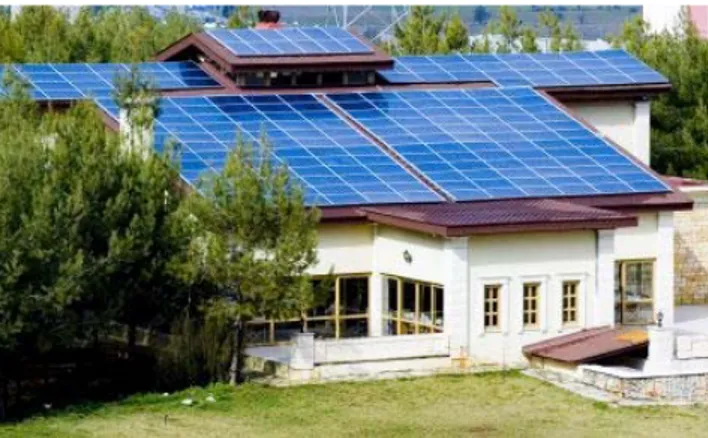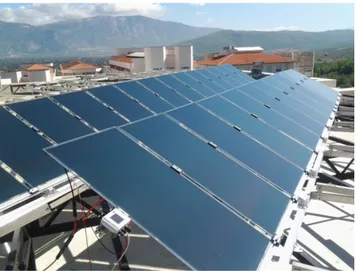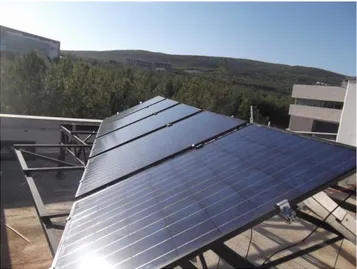© 2015 WILEY-VCH Verlag GmbH & Co. KGaA, Weinheim
p s s
current topics in solid state physics
c
status
solidi
www.pss-c.com
physica
Phys. Status Solidi C 12, No. 9–11, 1276– 1279 (2015) / DOI 10.1002/pssc.201510112
PV outdoor tests and 12 years
of Muğla experiences
Rustu Eke*
Mugla Sıtkı Kocman University, Faculty of Sciences, Department of Physics and Clean Energy R&D Centre, 48120 Mugla, Turkey Received 15 June 2015, revised 15 September 2015, accepted 12 October 2015
Published online 2 November 2015
Keywords photovoltaic performance, outdoor tests, characterisation
* e-mail erustu@gmail.com, Phone: +090 2522111601
© 2015 WILEY-VCH Verlag GmbH & Co. KGaA, Weinheim
1 Introduction Photovoltaic (PV) technology has
become one of the most important renewable sources in the world. By the end of 2014, total installed capacity for PV globally amount to at least 177 GW up from nearly 140 GW in 2013, according to the International Energy Agency's Photovoltaic Power Systems Programme (IEA-PVPS). And PV represents at least 1% of the global elec-tricity demand based on 18,400 TWh of elecelec-tricity con-sumption. (IEA – Key World Energy Statistics 2013 and 2015) [1].
Muğla is located in south west of Turkey at 37° 13’ latitude and according to the calculations; average monthly solar energy per square meter is just above 50 kWh for De-cember and January and well over 200 kWh for June and July [2]. Humidity sensor, wind speed sensor, wind direc-tion sensor, ambient temperature sensor and air pressure sensor are form weather station which was established on the top the Menteşe Library. Performances of photovoltaic systems for different conditions are being investigated by meteorology station.
Solar energy measurements for Turkey are carried out by Renewable Energy division of General Directorate of Renewable Energy and yearly average sum of solar
radia-tion of Turkey is about 1350 kWh and measured solar po-tential of Mugla is approximately 30% over the country’s average.
Mugla Sıtkı Koçman University has 120 kWp installed PV power with different application types and 84% of this installed power is grid connected. Overall annual produced PV electricity is about 85,000 kWh and the cumulative electricity is over 750,000 kWh from start-up.
In this study, outdoor solar measuring system, some of the obtained results and Mugla experiences for 12 years is summarized.
2 Experimental Although there is only 120 kWp
in-stalled power at Mugla Sıtkı Koçman University, it can cover 4% of the demand of the electricity used in the main campus. Besides this, PV covers only 3% of the electricity demand in Europe which is 1.15% at the end of 2010 [3]. This is a good ratio compared with the results obtained for Europe. The target of the covering ratio is 5% in 2020 [4].
A multi-channel measurement system in Muğla Sıtkı Koçman University Clean Energy Resources Research and Development Center (MUTEK R&D) developed by Aes-cusoft which can scan the whole current-voltage curve of a
In this paper, the electricity yield of photovoltaic power plant applications in the main campus of Muğla Sıtkı Koçman Uni-versity, Turkey is presented. There are four small scale grid connected photovoltaic power plants installed in the main campus. They are installed on the top of Menteşe Library of Muğla Sıtkı Koçman University, on the roof of Turkevi Student Cafeteria, on the façade and on the east and west towers of Staff's Block of the Building of Education Faculty and two double axis tracking systems. The systems are instal-led in 2001, 2003, 2008 and 2009 with rated powers between
10 kWp and 40 kWp. There are also several lamp-posts at the campus in various locations. All power plants are monitored from the start up and the collected data are analysed in sev-eral conference proceedings and papers individually. This pa-per summarizes the electricity yield and the pa-performance of photovoltaic power plants by the way that indicator of system quality which is called performance ratio (PR) and efficiency for each photovoltaic power plants, after their installation and also their presentation is itemized.
Phys. Status Solidi C 12, No. 9–11 (2015) 1277
www.pss-c.com © 2015 WILEY-VCH Verlag GmbH & Co. KGaA, Weinheim
Contributed Article
solar cell or photovoltaic module in 20 seconds [4]. This solar measuring system scans the voltage of solar cell or PV module under test at 80 points from the value around short circuit current (0 V) to the open-circuit voltage (VOC)
and current value corresponding to each voltage value is measured and saved in a file. These measurements can be performed in a 2 minute period. Variations in the internal parameters of the solar cell or PV module can be observed within a day or between seasons by using the obtained cur-rent-voltage curves. The measurement principle (Fig. 1) and the outer connection box of the multi-channel meas-urement system are given in Fig. 2. Four points measure-ment method is used (2 cables for load and 2 cables for sense) for the current and voltage measurements of the tested PV modules.
Figure 1 Measurement principle for the outdoor I-V curve multiswitch setup.
Figure 2 Outer connection unit to the solid relay based module switch.
Parameters of solar cell and PV module vary under op-erating conditions. The actual performances o tested cell or modules are obtained and these values are compared those given under STC (standard test conditions: 1000 W/m2 ir-radiation and 25 °C operating temperature). STC condi-tions combine solar irradiation on a clear summer day, temperature of solar cell or photovoltaic module on a clear winter day and solar spectrum on a clear spring day. How-ever, these conditions are encountered rarely. High irradia-tion levels occur on surfaces of PV modules exceeding
1000 W/m2in summer months; because of the high ambi-ent temperature, operating temperatures of PV modules may reach up to 60-70 ºC. In winters, although ambient temperature and the consequent operating temperature of PV modules are lower (it is close to 50 °C at noon time), solar irradiation.
Four grid connected PV systems have been installed at the Muğla Sıtkı Koçman University PV Outdoor Test Site to analyse performance characteristics by field tests. The nominal power of both PV arrays range from 2.28 kW to 2.6 kW. PV arrays are the representative of four different PV arrays mono crystalline silicon, multi crystalline silicon, amorphous silicon and CdTe thin films modules of about 2.5 kWp installed power. Specifications of each type of module and array are summarized in Table1. For analysing the relation between electricity yield and PV module physical parameters one PV module from each array is tested with the multiswitch setup.
Table 1 Specifications of PV power plants under test on the roof
of Menteşe Library.
Module Type Thin Film CdTe a:Si sc-Si mc-Si Quantity 60 45 19 26 Connection 5s12p 5s-9p 19s 13s-2p Max. PV Mod.
Powers (Wp) 43 58 120 105 Max. Array Power
[kWp] 2.58 2.61 2.28 2.60
First BIPV application in Turkey is applied on the roof of a student cafeteria in the main campus. 210 pieces of mc-Si PV modules are plugged to form 25.6 kWp installed power (a photo of the cafeteria taken in 2010 is given in Fig. 3) where the system produced about 320 MWh of electricity from June 2013.
Figure 3Turkey student cafeteria with 25.6 kWp grid connected BIPV application.
Two different types of PV modules with different tech-nologies are used on the towers and on the facade of the building to form a 40 kWp (Fig. 4) installed power of a second BIPV application in Muğla Sıtkı Koçman
Univer-1278 R. Eke: PV outdoor tests and 12 years of Muğla experiences
© 2015 WILEY-VCH Verlag GmbH & Co. KGaA, Weinheim www.pss-c.com
physica
p s s
statussolidi
c
sity campus [5, 6]. Single and triple junction amorphous silicon PV modules were used on the façade and on the two towers of building. Totally 541 m2 is covered. The ori-entation of building is 30° east from south. Cumulative electricity yield of the BIPV system is over 300 MWh at the end of 2014. There is a logging unit for collecting the electrical data of the BIPV system, two different (one is vertical the other has the same tilt angle with the PV mod-ules on the facade) irradiation sensors and two temperature sensors (one for ambient the other for PV modules on the façade). One module from each type of installation is put under test on the outdoor characterisation system to see the performance of the system.
Figure 440 kWp BIPV application.
Another PV application installed in the main campus is two identical double axis solar tracking systems (Fig. 5). Back contact single crystalline silicon modules are used in each tracking PV system and 84 modules are used to form 15.6 kWp installed power [7, 8]. It is the first installation of back contact mono crystalline silicon PV modules in Turkey. One module is under test in PV outdoor test site to monitor and analyse the outdoor performance.
There are two identical PV systems (the same from PV modules, wirings to inverters), one set in a fixed tilt angle and the other is working in double axis tracking mode. The PV systems are installed at the end of 2008 and the cumu-lative electricity produced and fed to grid is about 100 MWh at the end of 2014.
For testing the performance of another thin film based PV material based PV modules copper indium gallium di- selenide (CIGS) 2 kWp installed powered PV modules (Fig. 6) were used and two individual PV modules are also under test to compare the output results.
Figure 5 Double axis solar tracking applications.
The latest PV application in campus is a compact hybrid system. The installation is only 1 kWp with 5 modules both has PV on the front surfaces and has pipes at the back surface of the module (Fig. 7). These types of modules are called as PVT modules. The performance of
Figure 6 CIGS PV system application.
the system will be calculated through a MSc project [9]. The energy and the overall efficiency (including efficiency of the thermal side) of the system and one moduled plugged to the test system will be analysed.
All PV systems have their monitoring units and at least one or two PV modules used in applications are put under test. All monitoring systems are plugged in LAN so they are accessible from any computer in the campus.
Phys. Status Solidi C 12, No. 9–11 (2015) 1279
www.pss-c.com © 2015 WILEY-VCH Verlag GmbH & Co. KGaA, Weinheim
Contributed Article
Figure 7 PVT system under test.
3 Result and discussion Within 12 years an
unin-terruptible current-voltage measuring unit is put on the roof of Menteşe library to get the current voltage data of different sized photovoltaic modules from sunrise to sunset with different meteorological conditions. Some physical parameters of the tested PV modules are investigated with this high precision setup.
Muğla Sıtkı Koçman University have different sized small scale PV applications in its main campus and it cov-ers 3.5% of its electricity demand from PV which is over the recent value of Europe.
For initial predictions of the PV systems PVSYST simulation program is used [7]. The measured results show that simulation results differ only 5% of annual electricity output results. The BIPV projects show that PV is an at-tractive solution for southwest of Turkey. The projects suggest that BIPV applications are attractive for grid-connected photovoltaic installations in the south west part of Turkey.
Different performance ratios and different energy rat-ing values are calculated dependrat-ing on the installation type and PV module type. For vertical mounted PV modules the lowest energy rating value is measured as 950 kWh/kWp and for the back contact single crystalline silicon PV mod-ules on the double axis trackers 2050 kWh/kWp values are calculated.
The performance of commercially widespread used crystalline silicon and other thin film PV modules are also investigated at Muğla Sıtkı Koçman University and it was found that thin film modules are performing better than crystalline PV modules in summer for Muğla which is found as the same with coastal regions. But in winter it is found that crystalline silicon PV systems’ performances are better than thin film PV module based systems. In many systems inverters with transformer and without transformer are used for different technology based PV systems.
Most of the systems are still working on their 70% of installed power. Mugla Sıtkı Koçman University has 120 kWp installed PV power and 84% of it is grid connected. These values show that over 85,000 kWh annual electricity can be produced from PV in Mugla Sıtkı Koçman Univer-sity from the installed several PV systems and over 750,000 kWh of electricity is produced from PV since the installations has started.
4 Conclusions The current-voltage curves for
sev-eral PV modules at the Mugla Sıtkı Kocman University PV Outdoor Test Site is analysed in many studies. The rela-tionship between the environmental seasonal variations and internal parameters were analysed.
In this study, PV ourdoor tests and 12 years of experi-ence of PV systems installed at Mugla Sıtkı Koçman Uni-versity is presented. There are four different application types, ground mounted test systems, BIPV systems and two double axis tracking systems with different types of PV module technologies.
Although there is only 120 kWp installed power it can cover 3.3% of the demand of the electricity used in the main campus. The overall cumulative produced electricity is more than 750 MWh from the start-up of the installa-tions. Annual energy rating (electricity produced per in-stalled power) of the PV systems varies between 850 kWh and 2050 kWh.
Several (1 PhD and 6 MSc) graduate students use these PV systems within 5 years. And first largest PV applica-tions are installed in main campus.
Acknowledgement The systems summarized in this work
was financially supported by State Planning Organization (with code DPT 2001 K 120930) and Mugla Sıtkı Kocman University Scientific Research Projects (BAP) (with codes 08/10 and 12/27).
References
[1] IEA PVPS Report T1-26, Snapshot of Global PV Markets (2015), available from: http://www.iea-pvps.org/index.php?id=trends0.
[2] C. Oguz, MSc Thesis, Mugla University, 1999.
[3] EPIA, Global Market Outlook for Photovoltaics, 2014-2018 (2014).
[4] R.Eke, PhD Thesis, Ege University, 2007.
[5] R. Eke, S. Ozden, A. Senturk, and S. Oktik, in: Proc. First Turkish Solar Energy Conference and Exhibition-SolarTR-1, Ankara, Turkey, p. 13 (2010).
[6] R. Eke and H. Demircan, Energy Conversion and Management 65, 580 (2013).
[7] R. Eke and A. Senturk, in: Proc. 26th European Photovoltaic Solar Energy Conference and Exhibition (EUPVSEC), Hamburg, Germany, pp. 4363-66 (2010).
[8] R. Eke and A. Senturk, Sol. Energy 86, 2665 (2012).
[9] S. Kiraz and R. Eke, Research Symposium on Natural and Applied Sciences, Muğla, Turkey, 2015.


